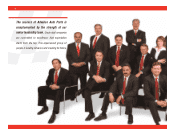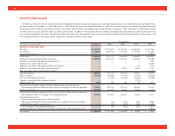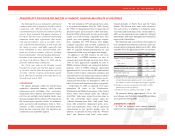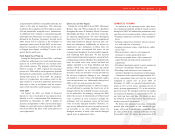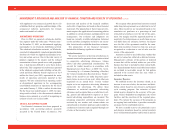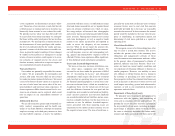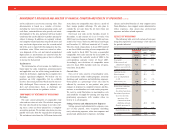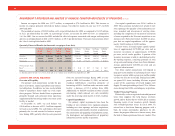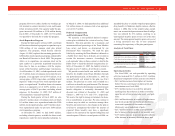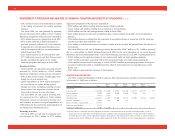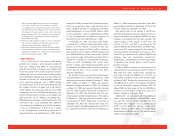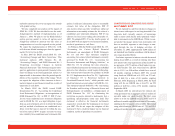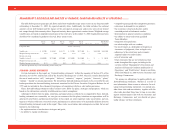Advance Auto Parts 2005 Annual Report Download - page 26
Download and view the complete annual report
Please find page 26 of the 2005 Advance Auto Parts annual report below. You can navigate through the pages in the report by either clicking on the pages listed below, or by using the keyword search tool below to find specific information within the annual report.
will supplement our commercial growth due to AI’s
established delivery programs and knowledge of the
commercial industry, particularly for foreign
makes and models of vehicles.
DISCONTINUED OPERATIONS
Prior to 2004, we operated a wholesale distribu-
tion segment under the trade name “Western Auto.”
On December 19, 2003, we discontinued supplying
merchandise to our wholesale distribution network.
The wholesale distribution network, or Wholesale,
consisted of independently owned and operated dealer
locations for which we supplied merchandise inven-
tory and certain services. Due to the wide variety of
products supplied to the dealers and the reduced
concentration of stores spread over a wide geographic
area, it had become difficult to serve these dealers
effectively. This component of our business operated
in the wholesale segment and excluding certain allo-
cated and Team Member benefit expenses of $2.4
million for fiscal year 2003, represented the entire
results of operations previously reported in that
segment. We have classified these operating results
as discontinued operations in the accompanying
consolidated statements of operations for the fiscal
year ended January 3, 2004 to reflect this decision.
For the fiscal year ended January 1, 2005, the oper-
ating results related to the discontinued wholesale
business were minimal as a result of recognizing an
estimate of exit costs in fiscal 2003.
CRITICAL ACCOUNTING POLICIES
Our financial statements have been prepared in
accordance with accounting policies generally
accepted in the United States of America. Our
discussion and analysis of the financial condition
and results of operations are based on these financial
statements. The preparation of these financial state-
ments requires the application of accounting policies
in addition to certain estimates and judgments by our
management. Our estimates and judgments are
based on currently available information, historical
results and other assumptions we believe are reason-
able. Actual results could differ from these estimates.
The preparation of our financial statements
included the following significant estimates.
Vendor Incentives
We receive incentives in the form of reductions to
amounts owed and/or payments from vendors related
to cooperative advertising allowances, volume
rebates and other promotional considerations. We
account for vendor incentives in accordance with
Emerging Issues Task Force, or EITF, No. 02-16,
“Accounting by a Customer (Including a Reseller)
for Certain Consideration Received from a Vendor.”
Many of the incentives are under long-term agree-
ments (terms in excess of one year), while others are
negotiated on an annual basis. Certain vendors
require us to use cooperative advertising allowances
exclusively for advertising. We define these
allowances as restricted cooperative advertising
allowances and recognize them as a reduction to sell-
ing, general and administrative expenses as incre-
mental advertising expenditures are incurred. The
remaining cooperative advertising allowances not
restricted by our vendors and volume rebates are
earned based on inventory purchases and recorded as
a reduction to inventory and recognized through cost
of sales as the inventory is sold.
We recognize other promotional incentives earned
under long-term agreements as a reduction to cost of
sales. These incentives are recognized based on the
cumulative net purchases as a percentage of total
estimated net purchases over the life of the agree-
ment. Our margins could be impacted positively or
negatively if actual purchases or results from any one
year differ from our estimates; however, the impact
over the life of the agreement would be the same.
Short-term incentives (terms less than one year) are
recognized as a reduction to cost of sales over the
course of the agreements.
Amounts received or receivable from vendors that
are not yet earned are reflected as deferred revenue.
Management’s estimate of the portion of deferred
revenue that will be realized within one year of the
balance sheet date is included in other current liabil-
ities. Earned amounts that are receivable from vendors
are included in receivables except for that portion
expected to be received after one year, which is
included in other assets.
Inventory Reserves
We establish reserves for inventory shrink, as an
increase to our cost of sales, for our stores and distri-
bution centers based on our extensive and frequent
cycle counting program. Our estimates of these
shrink reserves depend on the accuracy of the pro-
gram, which is dependent on compliance rates of our
facilities and the execution of the required proce-
dures. We evaluate the accuracy of this program on
an ongoing basis and believe it provides reasonable
assurance for the established reserves.
We have recorded reserves for potentially excess
and obsolete inventories based on current inventory
levels of discontinued product and historical analysis
MANAGEMENT’S DISCUSSION AND ANALYSIS OF FINANCIAL CONDITION AND RESULTS OF OPERATIONS
(continued)
24




